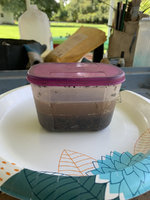Joe Dupre'
Masterpiece
I bought a bag of this stuff from Tractor Supply after researching and finding out that some people use it in aquariums. Obviously, you wouldn't want to use anything that would break down rapidly and risk the health of your fish. Seeing that, I devised a little experiement. I put about a cup in a sealed plastic container and filled it with water. I also put a cup in an open container filled with water. The sealed container gets a mild rolling agitation every few days. The open container get flooded every day when I water. After a month and a half, there is very mild cloudiness in both conainers. No rapid breaking down that I can see. No sludge in the bottom of either container. The product remains hard, but will break apart if you take a pinch and really scrub it together.
I'm not suggesting anyone use Safe T Sorb. This test gives an anecdotal example. BUT, after seeing this, I am starting to use about 30% of it in my Bald Cypress training pots. I also added a smaller percentage to my homemade "potting soil" mix.


I'm not suggesting anyone use Safe T Sorb. This test gives an anecdotal example. BUT, after seeing this, I am starting to use about 30% of it in my Bald Cypress training pots. I also added a smaller percentage to my homemade "potting soil" mix.






